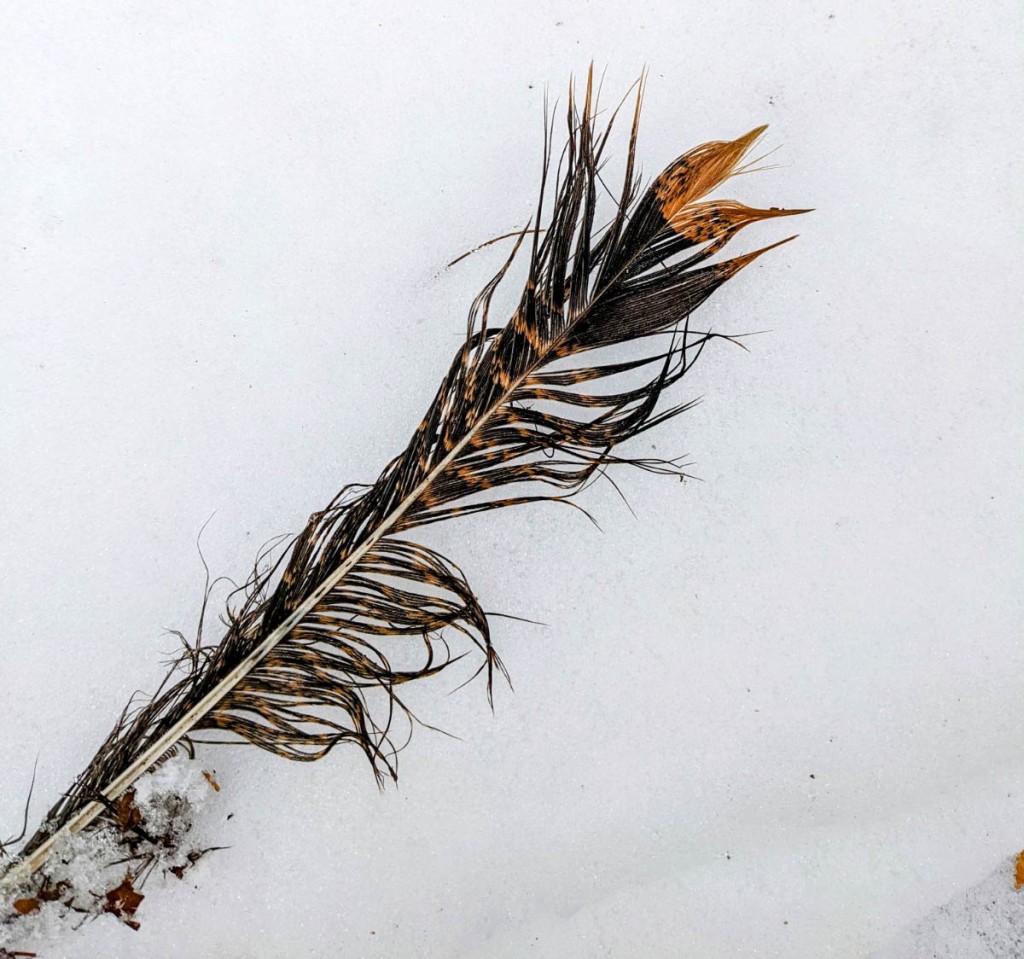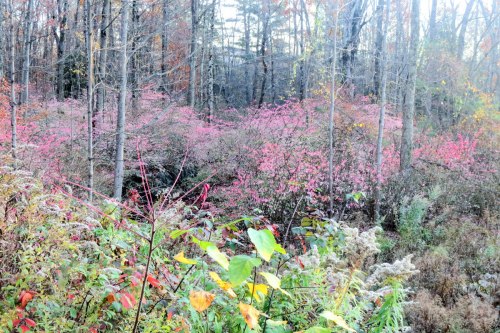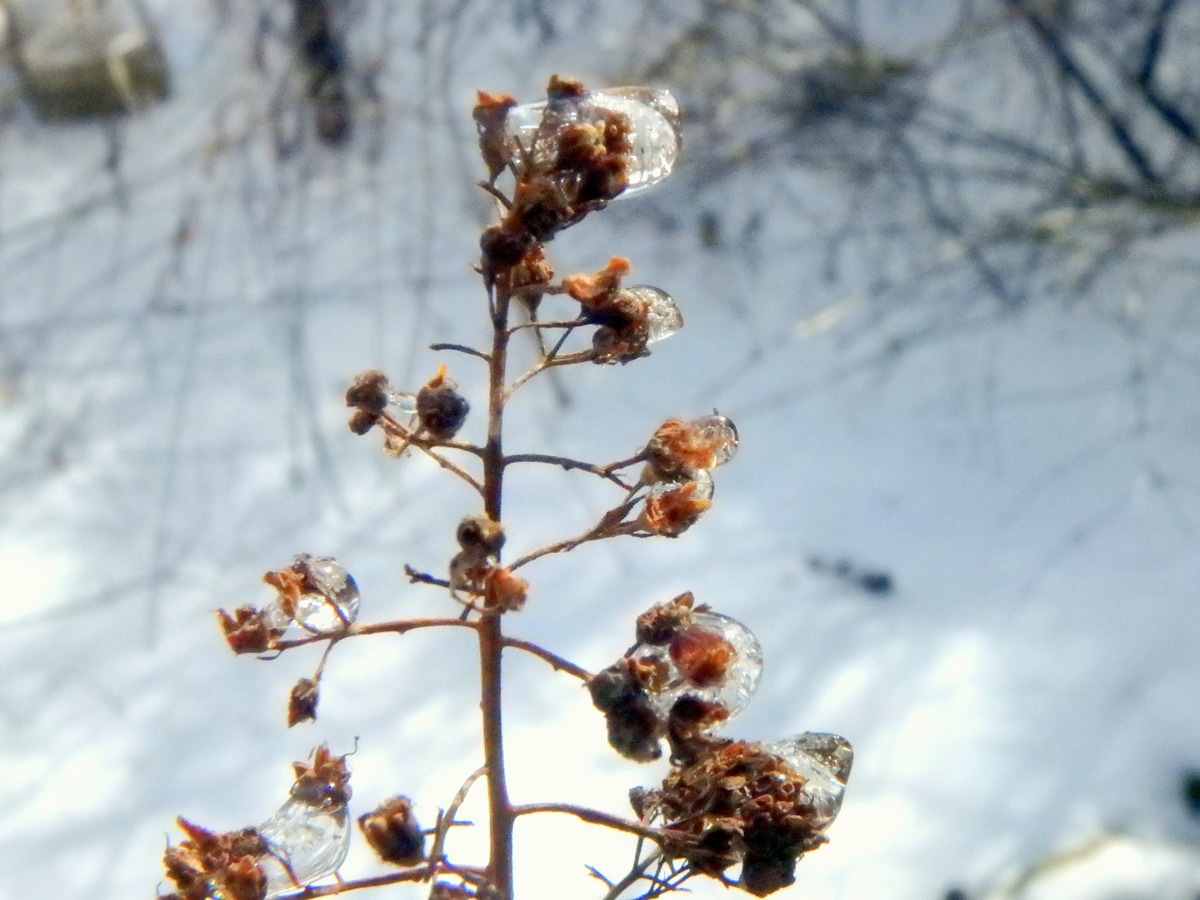
It got cold here last week; down into the 20s F at night, so I thought I’d go to the river and see if any ice baubles had formed overnight. It must not have gotten cold enough though, because I didn’t see any ice baubles. I did see plenty of beauty though, including the way that the early morning light played on the water of the river. The water was like liquid silk and so very beautiful; I could have watched it all day.

Before I go too far I should explain what ice baubles are for newer readers. The easiest way to explain them is to think of a candle. You dip the wick in hot wax over and over again, letting the wax harden between dips. If you think of the twigs in this shot from a couple of years ago as wicks, you can see how every wave crest “dips” the twigs in water and the cold air hardens that water into ice. Over time, often overnight, ice baubles like those seen here form. They are very clear and pure and often act like prisms when the sunlight hits them.

If it had been cold enough the lower parts of the aster and other plants here at the water’s edge would have been covered in ice. Even the stones get ice coated so you have to be careful where you step.

But I forgot about the ice when I saw how the sunlight was falling on the ripples. It was electric and mesmerizingly beautiful, as if bands of pure electricity were dancing over the surface of the water. Like the river had somehow captured lightning.

I watched this amazing dancing light for a while and I thought about how we at our essence, are pure energy. I think if someone had come walking along the riverbank and said “I am the light” I would have said “Yes, I can see that. And so are we all.”

The light was so beautiful, everywhere I looked.

Though it was cold enough for gloves and a hat I didn’t really see anything that would signify a freeze. I did see some nice frosty leaves on the mouse ear hawkweeds though. It showed how hairy these leaves are.

Fallen leaves had a bit of frost on them as well but I certainly wouldn’t say we had a “heavy frost.”

Beavers had been busy during the night and had dropped several trees including three or four oaks. These aren’t just any trees; they were bought and planted when the 200 year old timber crib dam was removed from the river at this site in 2010. I don’t know who chose or planted the trees but they really should have hired a botanist. They planted pines so close to the deciduous trees the pines are now shading them out. Since pines grow almost twice as fast as trees like oak, maple and ash, the deciduous trees have never really had a chance to get off to a strong start. Unless the pines are removed the beavers might as well take them.

The evidence left behind by the beavers was easy to find and hard to deny.

There are lots of invasive Japanese barberry bushes here that form a prickly, impenetrable thicket that you can’t walk through; you have to walk around them. They choke out native plants but I’ve noticed that small animals like rabbits like to hide in them, most likely because predators can’t find a way through the thorns.

The birds didn’t get all the grapes. Or maybe they purposely left some behind.

Along with invasive Japanese barberry and Oriental bittersweet, the Asian burning bush is taking over this entire area. It’s a pretty thing that first came over as an ornamental but each plant grows many seeds and the birds love them. The plant is also known as “winged euonymus” and if you look closely at its branches in this shot you can see the corky “wings” that gave it that name.

I was hoping the burning bushes would have all turned soft pastel pink by this time but there was still a lot of green on them. I’ll have to watch carefully because once it gets cold enough all those leaves can drop off overnight. What you see here is just a small portion of the total number of bushes but this was the first time I’ve seen them from this spot. I would have been chest deep in water in this spot, probably hanging on to a tree, if the river had been high.

And here are the berries that make burning bushes so invasive. Each berry is smaller than a watermelon seed but birds come from all over to eat them.

Most of the clubmosses had let their spores go but this one’s “clubs” had refused to mature, for whatever reason. The clubs are actually called strobili, and are filled with sporangia. These plants are ancient, having been on earth for many thousands of years. They are also called “ground cedar” or “ground pine” but they have nothing to do with pine or cedar. They were once collected almost to extinction by people making Christmas wreaths. If I saw displays of wreaths made of clubmosses I would refuse to buy one, and I would tell the seller why.

Beavers cut the witch hazels every few years and then let them grow back before harvesting them again, but I did find one old enough to have a blossom on it.

A beautiful young beech peeked out from behind a maple.

I was surprised to find a small colony of big leaf asters here. I’ve been coming to this spot for many years and have never seen them here. Colonies of them can get quite large. It would be nice if this one did the same. They have beautiful two foot long sprays of white or sometimes purple flowers. The plants seem to have a habit of suddenly appearing in the least expected places but I find the largest colonies on sunny hillsides.

There are lots of American hornbeam trees here but they die young and don’t reach any great size, possibly due to the flooding that goes on here. Another name for the tree is muscle wood, because someone thought they saw “tendons” rippling underneath the tree’s “skin.” I don’t know if it’s a fact but these trees seem to retain lots of water. I’ve seen them so rotten inside it seemed like the bark was the only thing holding them together. The odd thing about that is how another name for the tree is ironwood, because it is so heavy and strong. I could see many lacy frullania liverworts on this tree’s bark. When it gets cold their color darkens so they’re much easier to see. Most reach to about baseball size.

American Hornbeams have lost their leaves by this time but they’re still easy to identify by their winged seeds, which hang at the end of young branches. The “wing” on each seed (nutlet) is a three lobed bract which catches the wind and takes the seed with it. The bracts and seed coating are light brown when ripe and most should be stripped from the tree by the gusty fall winds at any time now.

Some of the oaks that were planted here are swamp white oaks. In the fall their leaves can be quite colorful.

This view looks downriver and shows a relatively open riverbank there on the left, but it is slowly being taken over by willows, which form a thicket like a wall. They prevent access to the water and that’s too bad, because fishers, swimmers, picnickers, children, and people like myself come here precisely so they can get close to the river. Easy access to the river is the draw; the true value of the place, but town planners can’t seem to see it.

But just the same, the willows are beautiful too. I’ll let nature do what it will and be at peace with it. This area floods each year and over the past four or five years the floods have crept further up the bank to create a river width that I never thought I’d see. I come here in spring each year and the high water mark is always easily seen, often at least a few inches or so higher than it had been the previous year. If it continues to go the way it has been I’m guessing that eventually much of what we’ve seen in this post will simply be washed away. There are already signs of it happening.

I’ll leave you with another look at the beautiful morning light on the water. I hope you enjoyed seeing it as much as I did.
The breeze at dawn has secrets to tell you. Don’t go back to sleep. ~Rumi
Thanks for stopping in.












































































































































































































